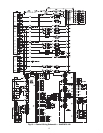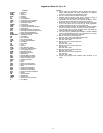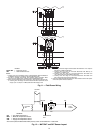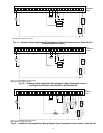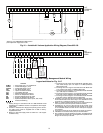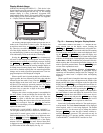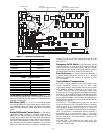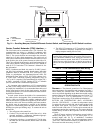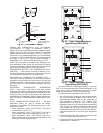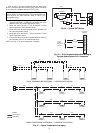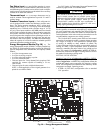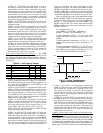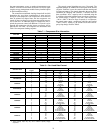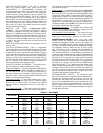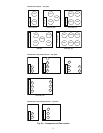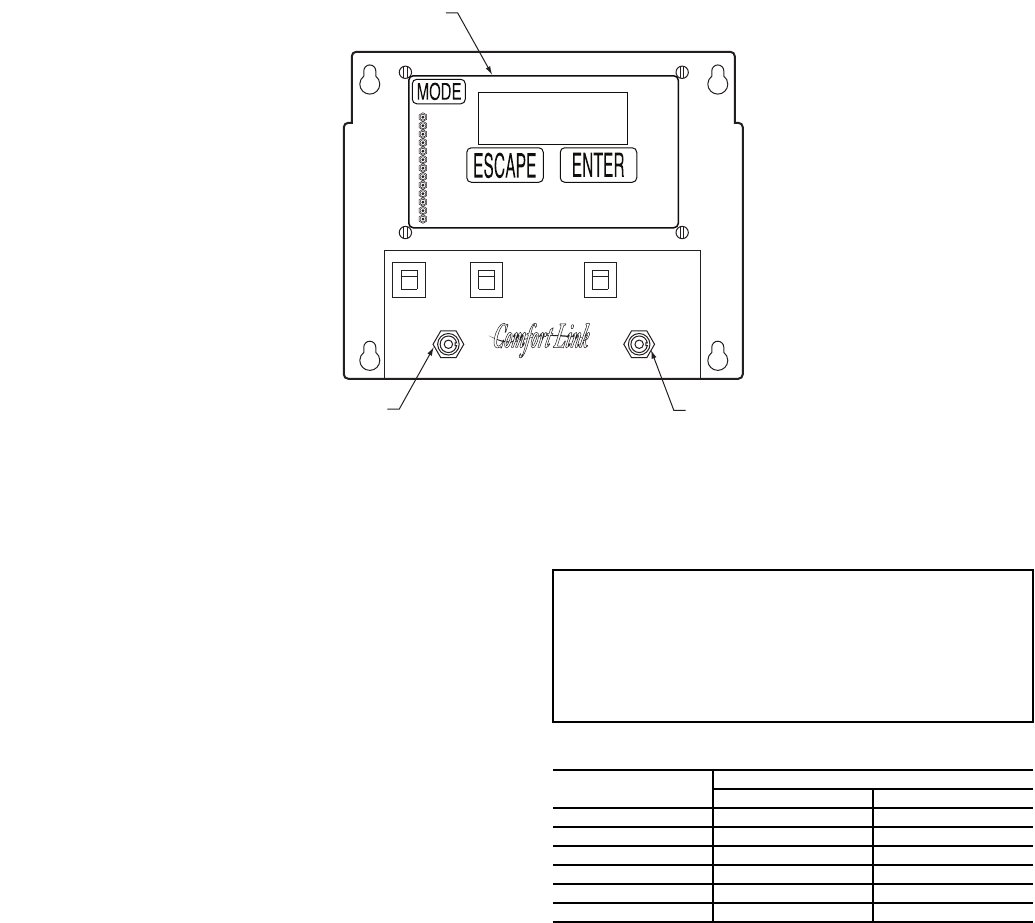
20
Carrier Comfort Network
®
(CCN) Interface —
The 38AP units can be connected to the CCN if desired. The
communication bus wiring is a shielded, 3-conductor cable
with drain wire and is supplied and installed in the field. See
Table 5. The system elements are connected to the communi-
cation bus in a daisy chain arrangement. The positive pin of
each system element communication connector must be wired
to the positive pins of the system elements on either side of it.
This is also required for the negative and signal ground pins of
each system element. Wiring connections for CCN should be
made at LVT. Consult the CCN Contractor’s Manual for fur-
ther information.
NOTE: Conductors and drain wire must be 20 AWG (Ameri-
can Wire Gage) minimum stranded, tinned copper. Individual
conductors must be insulated with PVC, PVC/nylon, vinyl,
Teflon, or polyethylene. An aluminum/polyester 100% foil
shield and an outer jacket of PVC, PVC/nylon, chrome vinyl,
or Teflon with a minimum operating temperature range of
–20 C to 60 C is required. Wire manufactured by Alpha (2413
or 5463), American (A22503), Belden (8772), or Columbia
(02525) meets the above mentioned requirements.
It is important when connecting to a CCN communication
bus that a color coding scheme be used for the entire network
to simplify the installation. It is recommended that red be used
for the signal positive, black for the signal negative, and white
for the signal ground. Use a similar scheme for cables contain-
ing different colored wires.
At each system element, the shields of its communication
bus cables must be tied together. If the communication bus is
entirely within one building, the resulting continuous shield
must be connected to a ground at one point only. If the commu-
nication bus cable exits from one building and enters another,
the shields must be connected to grounds at the lightning
suppressor in each building where the cable enters or exits the
building (one point per building only). To connect the unit to
the network:
1. Turn off power to the control box.
2. Cut the CCN wire and strip the ends of the red (+), white
(ground), and black (–) conductors. (Substitute appropri-
ate colors for different colored cables.)
3. Connect the red wire to (+) terminal on LVT of the plug,
the white wire to COM terminal, and the black wire to the
(–) terminal.
4. The RJ14 CCN connector on LVT can also be used, but is
only intended for temporary connection (for example, a
laptop computer running Service Tool).
Table 5 — CCN Communication Bus Wiring
OPERATING DATA
Sensors — The electronic control uses 3 to 7 thermistors to
sense temperatures for controlling unit operation. See Table 3.
These sensors are outlined below. Three different thermistor
curves are utilized depending on the thermistor and the config-
uration of the input. The three different types are 5 kat 77 F
(25 C), 10 kat 77 F (25 C), and 86 k at 77 F (25 C). See
Thermistors section on page 49 for additional information.
RETURN AIR TEMPERATURE (RAT) ACCESSORY
(Part No. 33ZCSENSAT) — A return air temperature sensor
is required for unit sizes 040-100 and all units equipped with
the digital scroll option. The sensor is field installed in the
indoor unit and wired to the LVT of the unit to measure the air
temperature entering the evaporator coil. The sensor should be
located directly in front of the evaporator coil after an outside
air intake.
The RAT sensor consists of a thermistor encased within a
stainless steel probe. See Fig. 22. The sensor probe is 6 in.
nominal length with 114 in. of unshielded, 2-conductor
18 AWG twisted-pair cables. The sensor temperature range is
–40 to 245 F with a nominal resistance of 10,000 ohms at 77 F.
The sensor has with an accuracy of ±0.36 F.
IMPORTANT: A shorted CCN bus cable will prevent some
routines from running and may prevent the unit from start-
ing. If abnormal conditions occur, unplug the connector. If
conditions return to normal, check the CCN connector and
cable. Run new cable if necessary. A short in one section of
the bus can cause problems with all system elements on the
bus.
MANUFACTURER
PART NO.
Regular Wiring Plenum Wiring
Alpha 1895 —
American A21451 A48301
Belden 8205 884421
Columbia D6451 —
Manhattan M13402 M64430
Quabik 6130 —
CB1
REMOTE
CONTROL
ENABLE
SCROLLING MARQUEE
DISPLAY
ENABLE/OFF/REMOTE
CONTACT SWITCH
EMERGENCY
ON-OFF SWITCH
SW1 OFF
OFF
ON
SW2
CB2 CB3
Fig. 21 — Scrolling Marquee, Enable/Off/Remote Contact Switch, and Emergency On/Off Switch Locations
LEGEND
CB — Circuit Breaker
SW — Switch



